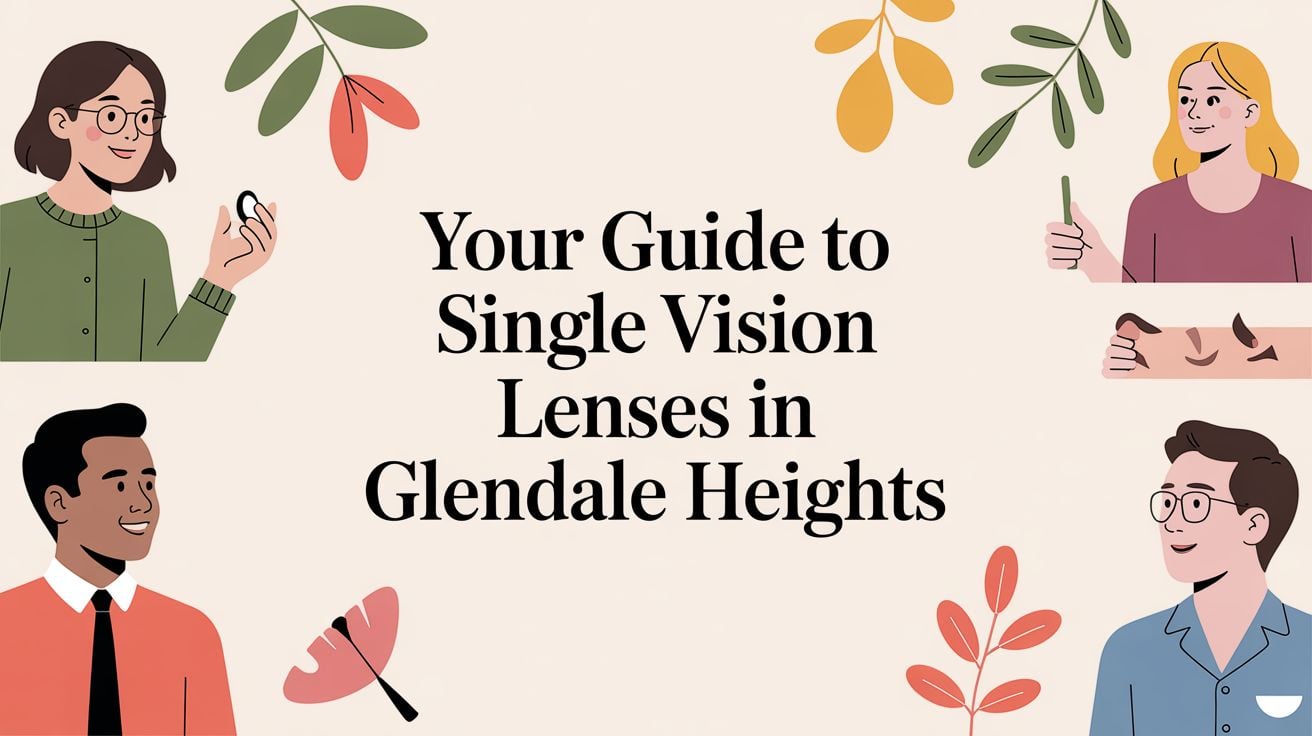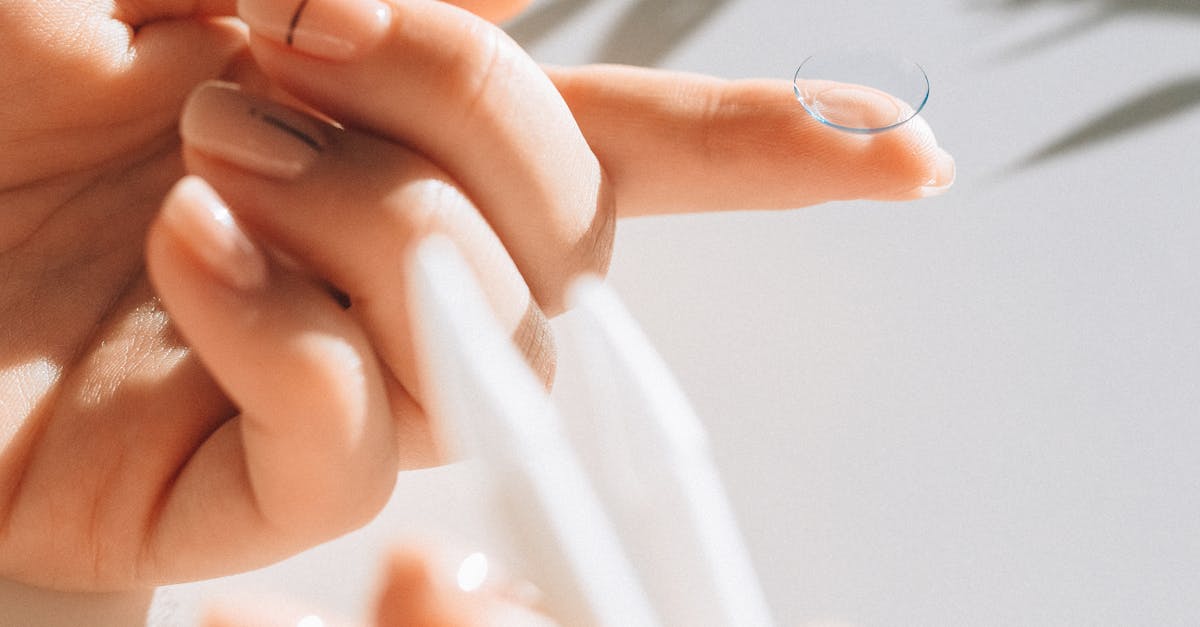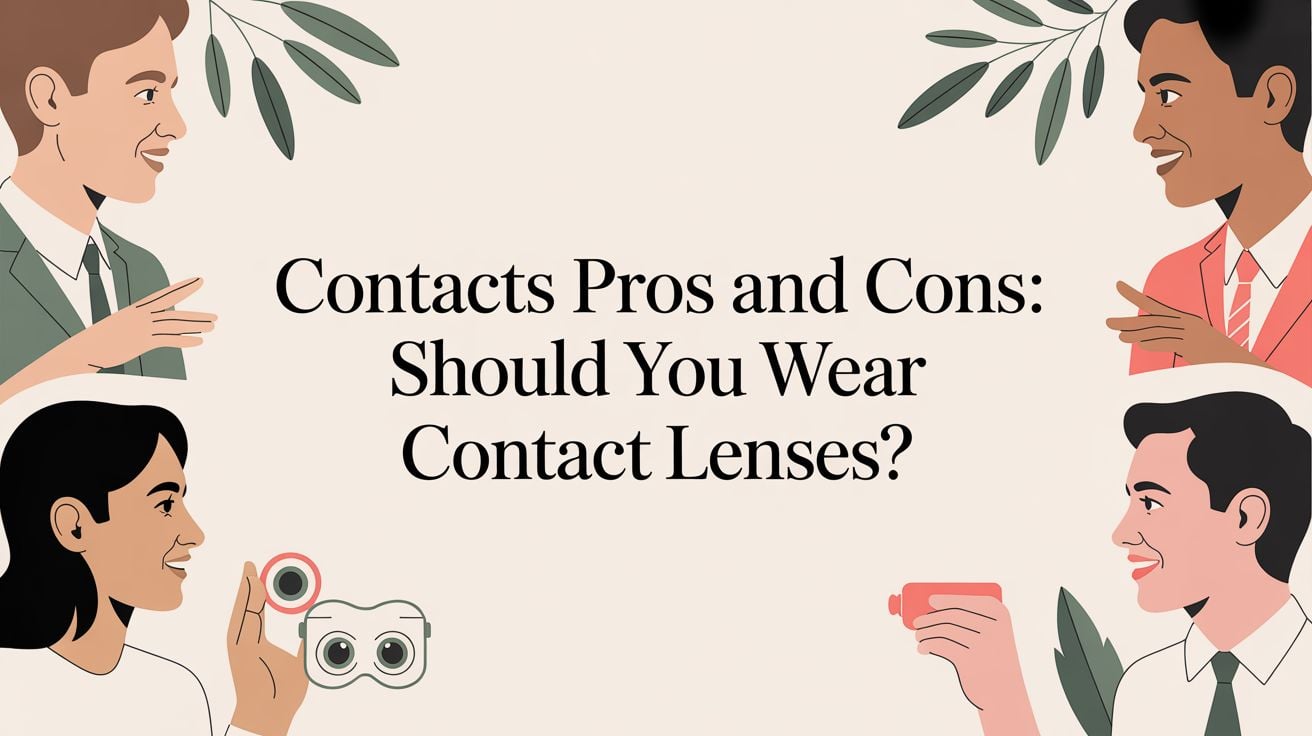If you’ve ever found yourself doing the "trombone arm" — pushing a menu farther away just to read it — you know the frustration of age-related vision changes. For many people in Glendale Heights, this marks the start of juggling multiple pairs of glasses. But what if one tiny lens could do it all?
That's the magic behind multifocal contact lenses. Put simply, they have different prescription powers built right into a single, seamless lens. This allows you to see clearly whether you're reading a text message, working on your computer, or driving down North Avenue, all without ever reaching for reading glasses. At iDoctor, our high-end optometry boutique, we specialize in fitting these advanced lenses for our Glendale Heights community.
Seeing Clearly At Every Distance in Glendale Heights
For many of us here in Glendale Heights, that moment when you can't quite focus on your phone screen is a real turning point. This perfectly normal, age-related change is called presbyopia. It happens because the natural lens inside your eye gradually loses its flexibility, making it tough to focus on things up close.
For years, that meant bifocals or the constant annoyance of switching between distance and reading glasses. Today, we have a much better way.
How Multifocal Technology Works
Think of a multifocal lens not as a single-power lens, but as one with different "zones" cleverly designed into its surface. Each zone has a unique focusing power, and your brain quickly learns to select the one it needs for the task at hand.
- Near Vision: A zone dedicated to reading a book or sending an email.
- Intermediate Vision: The perfect power for looking at your computer or your car's dashboard.
- Distance Vision: For clear sightlines while driving down Glen Ellyn Road or watching a movie.
This design gives you back the natural, effortless vision you're used to, freeing you from the hassle of readers.
This technology is a direct solution for presbyopia, a condition that now affects more than 1.8 billion people worldwide. These innovative lenses use multiple optical zones to restore clear vision across all distances. You can explore more about the growing popularity of multifocal lenses here.
Let's break down how these zones work for everyday activities.
Multifocal Lenses At a Glance
The table below gives you a quick snapshot of how multifocal lenses help with common visual tasks.
| Vision Distance | How the Lens Helps | Common Activities |
|---|---|---|
| Near | The center or near zone of the lens provides powerful focus for up-close tasks. | Reading text messages, looking at a menu, tying a fishing lure. |
| Intermediate | A transitional zone provides clarity for arm's-length vision. | Working on a computer, checking your car's dashboard, cooking. |
| Distance | The outer zones of the lens allow for crisp, clear long-range vision. | Driving, watching TV or a movie, seeing a street sign clearly. |
Essentially, your eye and brain work together to naturally find the right focus through the lens without you even thinking about it.
At iDoctor, we specialize in fitting these sophisticated lenses. We know that our neighbors in Glendale Heights, Bloomingdale, and Carol Stream have active lives that demand clear, convenient vision. That’s why we provide detailed eye exams in Glendale Heights to see if multifocals are the right fit for your eyes and your lifestyle, so you can see your world without compromise.
The Clever Science Behind Simultaneous Vision
To really get a handle on how multifocal contacts work, you have to understand the brilliant idea they're built on: simultaneous vision. It might sound a bit technical, but the concept is surprisingly intuitive. Think of it like giving your eye a smart camera that keeps everything in focus, all at the same time.
Picture this: you're sitting at a cafe, trying to read a text message, but you also want to watch your friend walking toward you from across the street. A multifocal lens makes this happen by bending light from both near and far objects so they land on your retina simultaneously. Your eye is literally seeing both images at once.
Your Brain Does the Heavy Lifting
Now, this is where the real magic happens. Your brain steps in as the ultimate image processor. It gets all this visual information at once and instinctively filters through it, cherry-picking the clearest, most relevant image for whatever you’re trying to look at.
So, when you glance down at your phone, your brain automatically tunes into the "near" information and ignores the blurry "far" image. Look up, and it instantly flips its focus to the "distance" information. It's this incredible teamwork between your eyes, the lenses, and your brain that creates such a smooth, natural visual experience.
This sophisticated process is a huge leap forward, helping to minimize the frustrating ghosting and distortions that plagued older multifocal lens designs.
No More Hard Lines or Head-Tilting
If you’ve ever seen someone with bifocal glasses, you know about that obvious, distracting line. Multifocal contacts get rid of that completely. They provide a seamless, gradual transition between all your viewing distances. There are no sudden jumps in vision, just a continuous range of focus.
This gives our patients a truly freeing experience. You can go about your day without ever having to consciously think about how you need to see something.
The core idea of simultaneous vision is that it mimics your eye's natural focusing ability. It delivers a fluid field of view, letting you shift from reading a book to watching TV without any jarring adjustments or reaching for your readers.
This is exactly why a professional fitting is so critical. Here at iDoctor, our prescription contact lens specialists in Glendale Heights take the time to carefully assess how your eyes and brain work together. We make sure the lens design is a perfect match for your unique visual system, giving you the clear, effortless vision you need for every part of your life.
Exploring Different Multifocal Lens Designs
When it comes to multifocal contact lenses, there’s no such thing as a one-size-fits-all solution. Think of it like having different tools for different jobs—these advanced lenses come in several designs, each engineered for specific visual needs. Figuring out which one is right for you is the first big step, and it's something we help patients navigate every day.
The two most common designs you'll come across are Concentric and Aspheric. Both work on the principle of simultaneous vision (where your brain learns to pick the focus it needs), but they get there in slightly different ways.
The Concentric Design: A Target For Your Vision
Imagine a bullseye. That's a pretty good way to picture a concentric multifocal lens. This design is built with distinct, alternating rings of power—one for near vision, the next for distance, and so on. It’s a very direct and structured way to give your eye multiple focal points at once.
Depending on what you need most, these lenses can be made in two main ways:
- Center-Near: The very middle of the lens is set for up-close tasks like reading a text, while the outer rings handle clear distance vision.
- Center-Distance: This design flips the script. The central zone is dedicated to seeing things far away, which is great for activities like driving.
The distinct separation between these zones can deliver incredibly crisp vision. The best fit really comes down to your pupil size and what you spend most of your day doing.
The Aspheric Design: A Smooth Visual Ramp
Now, let’s look at the aspheric design. Instead of the hard-edged rings you find in a concentric lens, an aspheric lens provides a much more gradual, blended transition between prescription powers. It's less like a target and more like a smooth ramp, where the power changes seamlessly from the center of the lens out to the edges.
This blended approach often creates a more natural-feeling visual experience for many people and can do a better job of minimizing issues like glare and halos around lights. It’s very similar in concept to how progressive eyeglass lenses work, giving you a smooth shift as your focus moves from near, to intermediate, to far.
This visual gives you a great idea of how the central part of the lens can be weighted for either near or distance tasks, depending on the design.
As you can see, the specific design of the lens is what determines whether your close-up or long-range vision gets prioritized in that critical central viewing area.
To make the differences even clearer, here’s a quick breakdown of how these two popular designs stack up.
Comparing Multifocal Lens Designs: Concentric vs Aspheric
| Feature | Concentric (Ring) Design | Aspheric (Blended) Design |
|---|---|---|
| Power Distribution | Distinct, alternating rings for near and distance. | Gradual power change from the center to the edge. |
| Visual Experience | Can provide very sharp vision in specific zones. | More natural, seamless transition between distances. |
| Best For | People who need crisp, defined vision at set distances. | Wearers sensitive to visual "jumps" or halos. |
| Analogy | A bullseye target. | A smooth ramp. |
Ultimately, both designs are fantastic pieces of technology. The "better" one is simply the one that works best for your eyes and your life.
The key takeaway is that the right design is highly personal. Your success depends on a professional fitting where an optometrist matches the lens characteristics to your unique eye anatomy and lifestyle.
The only way to know for sure which option is best for you is to come in for one of our detailed eye exams in Glendale Heights. During your appointment, we'll assess your vision and talk through your daily habits to find the multifocal design that will deliver clear, comfortable sight at every distance.
So, Are Multifocal Contact Lenses Right For You?
We’ve covered the "how," but the real question is: will they actually work for you? For many people hitting that age where reading glasses become a constant accessory, these lenses are a game-changer. If you lead an active life and are tired of juggling different pairs of glasses, multifocals can offer incredible freedom.
That said, it’s important to go in with the right expectations. There's an adjustment period. Your brain needs time to learn how to process what you’re seeing through these new lenses, which can take anywhere from a few days to a couple of weeks.
During this initial phase, you might notice some slight visual quirks. Things like mild glare or halos around lights, particularly at night, are pretty common. But for most people, these effects simply fade into the background as their brain adapts. The key to getting past this phase successfully comes down to a professional evaluation and a really precise fitting.
What Makes for a Successful Fit?
Getting the right multifocal lens goes way beyond just your prescription numbers. A great optometrist will look at the whole picture, considering several personal factors to pinpoint the exact lens design that will give you sharp, comfortable vision.
A thorough fitting process will always look at:
- Your Prescription: Of course, your distance power and the "add" power needed for close-up tasks are the foundation.
- Pupil Size: How your pupils change in bright and dim light is a huge factor in how well certain lens designs will work for you.
- Your Lifestyle: What does your day look like? Are you staring at a computer screen, or are you constantly driving around town on roads like Army Trail Road? Your daily habits tell us which distances matter most.
Success with multifocal contacts is a partnership between advanced lens technology and your brain's amazing ability to adapt. Giving it a little time and having a lens that’s professionally fitted for your unique eyes are the keys to achieving clear, effortless vision.
Here at iDoctor, we specialize in helping Glendale Heights residents find out if they’re a great match for this technology. We believe in taking the time to understand your vision needs and getting the detailed measurements that are crucial for a successful fit.
You can dive deeper into our process and see the options we offer in our guide to multifocal contacts in Glendale Heights. Remember, picking the right eye doctor is every bit as important as picking the right lens.
Why a Professional Fitting at iDoctor Makes All the Difference
Knowing how multifocal contacts work is one thing, but actually seeing clearly and comfortably with them? That’s all about the fit. These lenses are incredible pieces of technology, but they aren’t a one-size-fits-all solution. Getting it right comes down to a careful, expert fitting process that considers the unique shape of your eyes and the demands of your daily life.
You can't just slap these lenses on and expect perfect vision. Their magic is tied directly to how they center on your eye and move when you blink. That's why a professional evaluation from the best optometrist in Glendale Heights is an absolute must if you're thinking about making the switch.
It's More Than Just Your Prescription
During our detailed eye exams in Glendale Heights, we dig much deeper than a standard vision test. We have to be incredibly precise, because even the slightest misalignment can throw your vision out of focus.
We take the time to measure several key factors:
- Corneal Curvature: Everyone's eye surface has a unique curve. Measuring this helps us find a lens that will sit properly and stay stable, which is crucial for consistent vision.
- Pupil Size: Your pupils change size in different lighting, and this directly affects how you access the different power zones in the lens. We measure this to ensure the lens optics work for you, whether you're in a bright office or a dimly lit restaurant.
- Lifestyle Assessment: We'll chat about your day-to-day life. Are you staring at a computer screen for hours, or are you constantly on the road driving around Glendale Heights? This helps us choose a lens design that supports the type of vision you rely on most.
Why the Right Fit is Everything
An ill-fitting multifocal lens is a recipe for frustration. It can lead to blurry, fluctuating vision and often causes people to mistakenly think, "these lenses just don't work for me." More often than not, the real problem was the fit, not the technology itself.
Our detailed approach ensures we pair your specific visual needs with the right lens, dramatically improving your chances of a seamless transition away from reading glasses.
Think of it this way: the goal is to perfectly align the optical sweet spot of the lens with your pupil. When that happens, your brain can effortlessly process all the visual information, giving you crisp, clear sight whether you're looking near, far, or in between.
Here at iDoctor, we bring together advanced diagnostic tools and a genuine understanding of how these lenses are supposed to work. Our thorough contact lens fitting is designed to give you the best possible shot at success. We’re committed to helping our patients in the Glendale Heights area discover the real freedom that comes with wearing the right multifocal contact lenses.
Ready to See Clearly at Any Distance in Glendale Heights?
So, how do multifocal contacts pull off this magic trick? It's a team effort between the lens design and your brain. Each lens has different zones for near, far, and in-between vision. Your brain naturally learns to look through the right part of the lens for whatever you’re focusing on, giving you clear sight without ever reaching for reading glasses.
Imagine the freedom of reading a menu, checking your phone, and then looking up to admire the view at Glendale Lakes Golf Club—all with the same pair of contacts. It’s about simplifying your life and getting rid of the constant on-and-off hassle of glasses.
At iDoctor, we're dedicated to helping our neighbors in Glendale Heights experience life with the best possible vision. Stop by our boutique to see our collection of designer eyeglasses in Glendale Heights, featuring frames from top brands like Cartier, Tom Ford, and Gucci, as well as stylish choices from Ray-Ban and Kate Spade. And if comfort is a top concern, you’ll want to check out our guide on the best contact lenses for dry eyes.
Your Next Step to Effortless Sight
Getting started is easier than you think. We're proud to be an in-network provider for all major vision insurance plans, ensuring that exceptional eye care is both accessible and affordable for our community.
The secret to success with multifocal lenses isn't just the technology—it's the fit. A precise, professional fitting by an optometrist who truly understands your eyes makes all the difference.
The only thing left to do is see if they’re right for you. Schedule your comprehensive eye exam with the top eye doctor in Glendale Heights today. Let's work together to bring your world back into sharp, comfortable focus. We can't wait to see you!
Frequently Asked Questions
How long does it take to get used to multifocal contacts?
Most people adjust to multifocal contact lenses within one to two weeks. During this time, your brain is learning to automatically select the correct prescription zone for different distances. A precise contact lens fitting at iDoctor is the most important factor for a quick and comfortable adaptation period.
Can I get multifocal contact lenses in Glendale Heights?
Absolutely. iDoctor is a premier provider of contact lenses in Glendale Heights. We carry a wide selection of multifocal lenses from all major brands. Our expert optometrists will conduct a detailed exam to determine the perfect type for your specific vision needs and lifestyle.
Are multifocal contacts a good option for computer use?
Yes, they can be excellent for computer work. Many modern multifocal designs feature an "intermediate" zone specifically for viewing screens at arm's length. During your exam, be sure to tell us about your daily screen time so we can select a lens that keeps your digital world comfortable and clear. We cover this topic more in our post on comfortable contact lenses.
Does iDoctor accept my vision insurance?
Yes, iDoctor proudly accepts all major vision insurance plans. Our team is happy to help you understand and maximize your benefits for services like comprehensive eye exams and specialized multifocal contact lens fittings. We believe premium eye care in Glendale Heights should be accessible and affordable.





